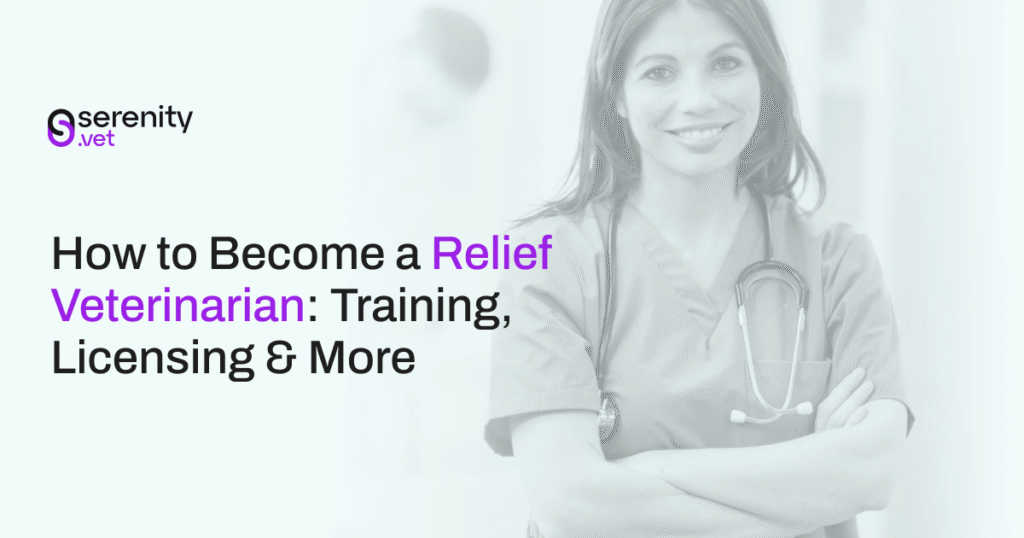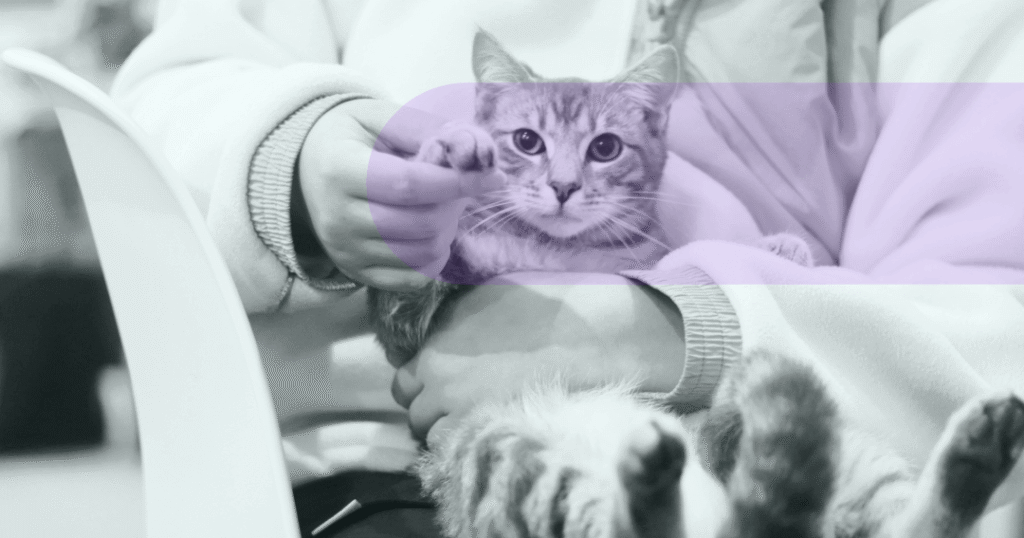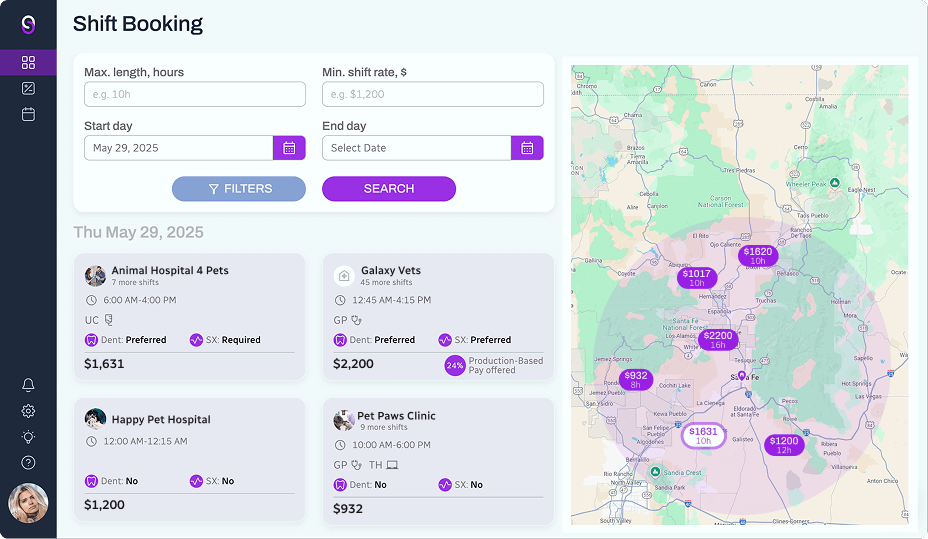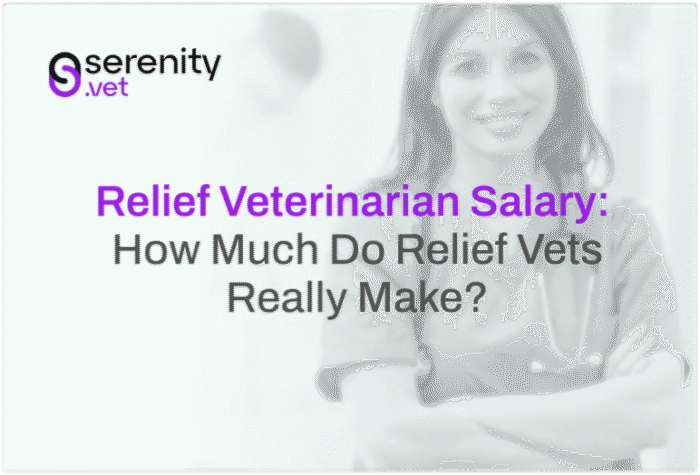
How to Become a Relief Veterinarian: Training, Licensing & More
Every vet knows that person — the one who sets their own schedule, travels between clinics, and seems to have cracked the code for work-life balance. They’re not tied to one hospital. They don’t spend their Sundays catching up on charts or navigating office politics. And somehow, they still manage to make good money.
That’s the relief veterinarian, and their ranks are growing fast. Burnout, staffing shortages, and rising client demand have turned relief work from a backup plan into a viable, even sought-after, career path.
Relief work offers freedom and variety, but it also requires planning, preparation, and the right foundation.
If you’re considering this path, we’ve put together a guide to help you get started. From education and licensing to business setup, insurance, and your first clients, here’s everything you need to build a flexible, independent, and financially sustainable relief career in the U.S. or Canada.
What Is a Relief Veterinarian?
A relief veterinarian is a licensed DVM who provides temporary coverage for clinics, stepping in when regular staff are on vacation, parental leave, or when caseloads spike.
Relief vets are independent professionals who choose their own hours, clients, and locations. Some work part-time to supplement a full-time job; others build a full career around it.
At a glance:
- Flexibility: Choose when and where you work.
- Variety: Gain experience across multiple clinic types and teams.
- Earning potential: Set your own rates and workload.
- Trade-offs: No guaranteed income or employer-provided benefits.
In short, relief work offers autonomy and variety, but it comes with the responsibilities of running a small business.
Find Relief Shifts on Your Terms
Enjoy flexibility, better pay, and total control over your schedule with Serenity Vet.
Step One: Education & Licensing Requirements
Before you can work as a relief vet, you’ll need the same foundation as any practicing DVM: a veterinary degree and a valid licence (or licences) to practice in the jurisdiction(s) where you work. Relief work doesn’t exempt you from these requirements — in fact, the mobility of relief work makes jurisdiction-compliance especially important.
Education

In both the U.S. and Canada, you’ll need a Doctor of Veterinary Medicine (DVM) degree from an accredited institution. In the U.S., that means a program accredited by the American Veterinary Medical Association’s Council on Education (AVMA-COE).
If you earned your degree outside North America, you’ll need to complete an equivalency program before applying for local licensure. The two most common are the Educational Commission for Foreign Veterinary Graduates (ECFVG) and the Program for the Assessment of Veterinary Education Equivalence (PAVE) in the U.S.
In Canada, international graduates go through the National Examining Board (NEB) process to obtain a Certificate of Qualification (CQ), which may involve additional exams such as the Basic and Clinical Sciences Exam (BCSE) or the Clinical Proficiency Exam (CPE).
🇺🇸 Licensing in the U.S.
To legally practice as a veterinarian, you must:
- Pass the North American Veterinary Licensing Examination (NAVLE)
This standardized exam is required in nearly all U.S. states and Canadian provinces and is the main step toward professional licensure. - Obtain a state veterinary license
Each state has its own veterinary board, application process, fees, and continuing education (CE) requirements. Some also require a state jurisprudence or law exam that covers local regulations. - Plan for mobility.
Relief vets who work across multiple states often hold more than one active license, or focus their work within a single region to simplify renewals and compliance.
🇨🇦 Licensing in Canada
Canadian relief vets follow a similar path:
- Earn a DVM from an accredited university or complete the NEB equivalency process and obtain your Certificate of Qualification.
- Pass the NAVLE.
- Register with your provincial regulatory body (for example, the College of Veterinarians of Ontario or the Alberta Veterinary Medical Association). Each province has its own registration process, fees, and CE requirements, and some require a jurisprudence exam before you can begin practicing.
| Category | 🇺🇸 United States | 🇨🇦 Canada |
|---|---|---|
| Degree Requirement | Doctor of Veterinary Medicine (DVM) from an AVMA-COE–accredited veterinary college. | Doctor of Veterinary Medicine (DVM) from an accredited Canadian veterinary college. |
| International Graduates | Must complete an equivalency program — either the Educational Commission for Foreign Veterinary Graduates (ECFVG) or Program for the Assessment of Veterinary Education Equivalence (PAVE) — before applying for licensure. | Must complete the National Examining Board (NEB) process to obtain a Certificate of Qualification (CQ), which may include exams such as the BCSE and CPE. |
| Licensing Exam | North American Veterinary Licensing Examination (NAVLE) — required by all U.S. states and Canadian provinces for veterinary licensure. | North American Veterinary Licensing Examination (NAVLE) — required by all provinces and territories for veterinary licensure. |
| Licensing Authority | Each state veterinary medical board regulates licensure, renewals, and practice standards. | Each provincial or territorial regulatory body (e.g., CVO, ABVMA) regulates licensure, renewals, and practice standards. |
| Additional Exams | Some states require a jurisprudence or state law exam covering local veterinary regulations. | Some provinces require a jurisprudence exam covering provincial veterinary laws and ethics. |
| Continuing Education (CE) | Ongoing CE hours required to renew a license every 1–2 years; requirements vary by state. | Ongoing CE hours required to renew a license every 1–2 years; requirements vary by province. |
| License Mobility | Relief veterinarians may hold multiple state licenses or focus on one region to simplify renewals and compliance. | Relief veterinarians may hold multiple provincial licenses or focus on one region to simplify renewals and compliance. |
Continuing Education
Most states and provinces require veterinarians to complete a set number of continuing education (CE) hours every one or two years to maintain an active license. Requirements vary: some boards specify in-person training, while others accept online coursework.
For relief vets, it’s important to plan ahead and budget for CE, since you won’t have an employer to remind you, track credits, or reimburse course costs. Staying proactive with CE keeps your licenses in good standing and helps you stay current across different practice settings.
Step Two: Essential Credentials and Insurance

Once you’re licensed, the next step is protecting yourself: legally, financially, and professionally. Relief vets don’t have an employer to handle benefits or coverage, so these essentials are entirely in your hands.
Controlled Substances Registration
🇺🇸 In the U.S. If you’ll be prescribing or administering controlled drugs in the U.S., you’ll need to register with the Drug Enforcement Administration (DEA).
- Many relief vets maintain their own DEA number for flexibility, though some clinics may allow you to use theirs if you’re working under their supervision.
- Keep your registration tied to your business address and up to date — DEA compliance issues can quickly derail your ability to work.
🇨🇦 In Canada, the regulation happens under the Controlled Drugs & Substances Act (CDSA).
- Clinics may hold the facility “dealer” or establishment authorizations, but every vet working there must follow the college / provincial standards for controlled drugs (inventory, storage, audits, disposal).
- As a relief vet, you must ensure the clinic’s framework is in place and know your role in the controlled-drug system.
Professional Liability Insurance
Malpractice coverage (often called professional liability insurance) is absolutely non-negotiable. It protects you if a client claims negligence or professional error.
- 🇺🇸 In the U.S., organizations like AVMA PLIT (Professional Liability Insurance Trust) offer coverage designed for relief vets (as employer policies may not apply to you).
- 🇨🇦 In Canada, coverage is often included through the CVMA (Canadian Veterinary Medical Association Insurance Program) or your provincial association membership.
Pro tip: Some clinics require proof of your policy before booking shifts — keep your certificate handy and updated annually.
Health and Disability Insurance
Because you’re operating independently, you won’t have employer-provided benefits.
- 🇺🇸 U.S. vets often combine ACA marketplace plans or private health coverage with disability insurance to protect income in case of illness or injury.
- 🇨🇦 In Canada, while provincial health covers core medical services, you may still want supplemental dental, prescription, and long-term disability coverage to avoid gaps.
Optional Certifications
While not required, certain credentials can help you stand out:
- Fear Free® Certification for client-friendly handling and communication.
- Emergency & Critical Care or Ultrasound courses to expand your service range.
- DEA-compliant handling and record-keeping training (for U.S. vets working ER or high-control cases).
The goal isn’t to collect certificates, it’s to build trust and signal competence to new clinics. The more plug-and-play you are, the more in-demand you’ll become.
Step Three: Setting Up Your Business

Relief vets are, by definition, self-employed. That means you’re not just a doctor, you’re also your own HR, finance, and legal department. The upside? Full control over your work. The trade-off? You’ll need to build some business structure behind your name.
Independent Contractor Basics
Most relief vets work as independent contractors.
- 🇺🇸 In the U.S., that means you’ll receive a 1099 form from each clinic (instead of a W-2).
- 🇨🇦 In Canada, you’ll report your income as self-employed to the CRA (Canada Revenue Agency).
This setup gives you freedom — to set your own rates, choose your clients, and deduct legitimate business expenses (like travel, CE, and equipment). But it also means you’re responsible for taxes and record-keeping.
Choosing a Business Structure
Your business structure determines how you’re taxed, what liability protection you have, and how official your operation looks to clinics.
🇺🇸 United States:
- Sole Proprietor: Easiest to set up; income is taxed on your personal return. Minimal protection if you’re sued.
- LLC: Adds liability protection and can simplify partnerships or brand building.
- S-Corp: May reduce self-employment tax if you’re earning six figures or more, though accounting is more complex.
🇨🇦 Canada:
- Sole Proprietorship: Simple, low cost, but no liability protection.
- Incorporation: More paperwork but greater tax flexibility and credibility when contracting with clinics.
- GST/HST Registration: Required if your annual income exceeds the provincial threshold (often around CAD $30,000, but this varies by province).
Pro tip: Start simple. You can always upgrade from a sole proprietorship to an LLC or incorporation once you’ve proven your income consistency.
Bookkeeping & Taxes
Relief work means multiple income sources — and no one withholding taxes for you.
- 🇺🇸 In the U.S., you’ll likely need to file quarterly estimated taxes to the IRS and your state to avoid penalties.
- 🇨🇦 In Canada, plan for quarterly remittances to the CRA if incorporated or earning significant freelance income, and ensure you’re registered appropriately for GST/HST if applicable.
Consider using accounting software (like QuickBooks), or hire a bookkeeper familiar with veterinary contractors.
Contracts That Protect You
Every relief agreement should clearly define:
- Your rate and payment schedule
- Shift hours and expectations (e.g., surgeries, ER, overnight)
- Cancellation terms and liability coverage
- Who provides medical records access, controlled substances, and equipment.
Pro tip: Never assume “standard terms”. Clinics vary widely, and a written contract keeps everyone aligned.
Marketing & Networking
Even the best clinicians need visibility. Start with the basics:
- A clean LinkedIn profile with a professional headshot and clear “Relief Veterinarian” title.
- A simple website or landing page listing your services, regions covered, and contact info.
- Join local and online vet communities — from Facebook groups to professional associations.
Word-of-mouth is your best marketing channel, but clinics can only recommend you if they remember you.
Step Four: Building Experience & Credibility

Once your licenses and business foundation are in place, the next challenge is getting your foot in the door, and earning the kind of reputation that keeps your calendar full.
Relief work runs on trust. Clinics need to know that when you walk in, the day will run smoothly, patients will be cared for, and staff won’t feel overwhelmed. That trust is what turns one-off shifts into recurring bookings and steady income.
Start Small, Build Smart
If you’re transitioning from a full-time associate role, start part-time. Pick up weekend or holiday shifts to get a feel for different clinic workflows.
- It’s a lower-risk way to test the waters and figure out what kind of practices and teams you click with.
- Keep notes on systems (like PIMS platforms and SOPs) you encounter — patterns emerge fast, and the more adaptable you are, the easier onboarding becomes.
Finding Your First Clients
The first few clients often come from your existing network.
- Let former colleagues, reps, and classmates know you’re taking relief work. Word travels fast in VetMed.
- Post your availability on veterinary job boards or local Facebook groups.
- Join professional platforms (like Serenity Vet) that connect verified relief vets with clinics looking for coverage without the endless back-and-forth.
Build a Reputation, Not Just a Resume
In relief work, reliability is currency. Show up early, stay flexible, and communicate clearly about your limits and preferences. Small details (like leaving thorough medical notes or getting on well with the team) leave lasting impressions.
Over time, your consistency becomes your calling card, and clinics will reach out directly before they even post openings.
Pro tip: Ask for feedback after your first few shifts. A quick “Was there anything I could do differently next time?” can turn a one-time gig into a long-term partnership.
Keep Learning
Each new clinic is a crash course in workflow, culture, and medicine. Treat every assignment like a continuing education opportunity.
Many relief vets find they become sharper clinicians because they’re exposed to so many different teams, tools, and case types.
Checklist: How to Start as a Relief Vet
Ready to put it all together? Here’s your step-by-step checklist — everything you need to launch your relief career with confidence.
| Education & Licensing | 🎓 Earn your DVM (or accredited equivalent) 🧪 Pass the NAVLE 📋 Apply for your state (U.S.) or provincial (Canada) veterinary license 🔁 Track continuing education (CE) credits for renewals |
| Credentials & Insurance | 🇺🇸 Apply for a DEA registration if prescribing controlled substances 🇨🇦 Verify CDSA compliance under clinic authorization 🛡️ Maintain active professional liability insurance 💰 Secure health and disability coverage — and plan for time off |
| Business Setup | 💼 Choose your structure (Sole Proprietor, LLC, or Corporation) 🧾 Track income and file quarterly taxes 🖋️ Create a professional relief contract template 🌐 Set up your online presence: website, LinkedIn, and profiles on relief platforms |
| Experience & Credibility | 🌱 Start part-time or weekends to gain experience 🏥 Build relationships with your first clinics ⭐ Collect references and feedback to boost credibility |
| Skills & Growth | 🔄 Stay adaptable — every clinic is different 💬 Communicate clearly with staff and clients ⚡ Keep learning: CE, certifications, and workflow efficiency 💚 Prioritize your wellbeing and work-life balance |
How Serenity Vet Makes Relief Work Easier

Relief work is rewarding, but it’s also a juggling act. Finding clinics, negotiating rates, managing payments, and keeping your schedule straight can start to feel like a second full-time job.
That’s where Serenity Vet comes in.
Instead of endless emails and spreadsheets, Serenity Vet gives relief vets and clinics a shared workspace — one platform where everything just fits.
Here’s how it helps:
- Connects you with the right clinics.
Browse verified opportunities that match your skills, preferences, and availability — no cold outreach required. - Simplifies payments.
Get paid quickly and securely without chasing invoices or waiting weeks for checks. - Gives you rate transparency.
See what clinics are offering up front and negotiate confidently. - Keeps your schedule organized.
Manage shifts, availability, and payments in one dashboard that syncs automatically. - Scales with you.
Whether you take a few shifts a month or work full-time, Serenity Vet grows with your business, giving you the freedom to focus on medicine, not admin.
Relief work doesn’t have to mean chaos. With the right tools, it can be the most flexible, sustainable, and rewarding chapter of your veterinary career.

